| Home |
| Acknowledgments |
| Conventions |
| Glossary |
| Maps |
| References |
| Links |
| Articles |
| Thumbnails |
| Species
list |
| Family |
| Next
species |
Additional Photos

detail
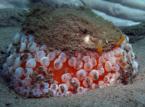
front
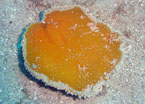
underside
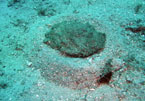
buried
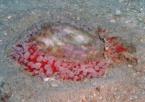
feeding
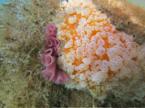
laying eggs

shell

Umbraculum sp. #3
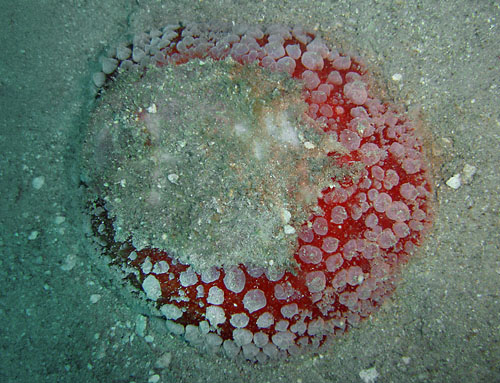
| Maximum size: about 165 mm. Identification: This is a large species with a broad, cap-shaped external shell covering the center of the notum. The mantle is covered with very large, cauliflower-like tubercles (though the tubercles may be patchily irregular in some individuals). Its background color is bright orange with broad, white tips on the tubercles. Young animals may have less well developed tubercles. Its shells are usually overgrown with algae and remnants of a hairy periostracum may be present around their margins. The shell is similar to the shell of Umbraculum sp. #2 but more heavily calcified than the shell of Umbraculum sp. #1. Natural history: Umbraculum sp. #3 is a moderately rare nocturnal species found primarily in Halimeda kanaloana beds and other sandy habitats. Rarely, it occurs in shallow rocky habitats and tide pools but usually in more protected areas than Umbraculum sp. #2. It may bury itself in sand during the day. It feeds on sponges and lays a frilly, pink egg mass (although the color of the egg mass may turn out to be variable). (Note 1) Distribution: Big Island, Maui, Oahu, Kauai and Midway: widely distributed in the Indo-Pacific. (Note 2) Taxonomic notes: This species is lumped with Umbraculum sp. #1 and Umbraculum sp. #2 as Umbraculum sinicum in Kay, 1979 and as Umbraculum umbraculum in Hoover, 1998 & 2006. It's referred to as the "umbrella shell" by Kay and the "umbrella slug" by Hoover in that context. However, its distinctive color, large cauliflower-like tubercles and different habitat suggest that it's likely to turn out to be a separate species. In Ostergaard, (1950), the egg mass of U. sinicum is described as pink but no mention is made of the color or morphology of the animal. So, if the egg mass color is consistent that source may also refer to this species. Pilsbry, 1917 states that "Umbraculum sinicum aurantiacum (Pse.) which Mr. Thaanum has taken at Hilo, appears to be sufficiently distinct from U. sinicum by characters of the shell to warrant a subspecific name." The name suggests that it might refer to this species but Umbraculum sp. #1 is also a possibility. (Note 3) The shells labelled U. sinicum in Morris, 1974 and Tinker, 1958 may be this species but their assignment is ambiguous. Photo: Warren Blum: about 130 mm: Maalaea Bay, Maui; Feb. 28, 2012. Observations and comments: Note 1: The two egg masses we've seen associated with this species were pink. However, orange forms from elsewhere in the Indo-Pacific have been photographed laying (or in association with) egg masses ranging from white to pink, perhaps reflecting differences in diet. Note 2: There is little variation in either background color or pattern throughout its range from Hawaii to East Africa. Note 3: This is speculative, of course. But, if future DNA work shows that the orange and brown forms from the Western Pacific are the same species (or, even lump with the Atlantic form) then this is the Hawaiian population that will probably group with them (with Umbraculum sp. #1 and Umbraculum sp #2 remaining as outliers). |
| Thumbnails |
Species
list |
Family | Next species | Top |